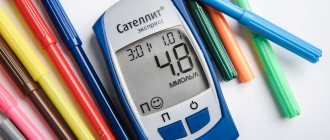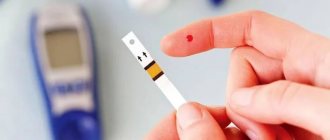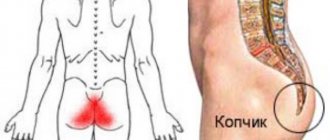What is type 1 diabetes and why is it dangerous?
The content of the article
Juvenile type 1 diabetes (T1DM) is a disease associated with metabolic disorders, namely a deficiency of the hormone insulin and increased concentrations of glucose in the blood. It is an autoimmune disease in which the immune system mistakenly destroys the body's own cells, making it difficult to treat. The disease affects both adults and children. A baby can become insulin dependent after suffering a virus or infection. If we compare statistics on type 1 and type 2 diabetes, type 1 diabetes occurs in approximately one in 10 cases.
Type 1 diabetes is dangerous due to severe complications - it gradually destroys the entire vascular system. For example, T1DM significantly increases the risk of developing cardiovascular diseases: people suffering from hyperglycemia are more likely to suffer strokes and heart attacks. The life expectancy of a woman suffering from type 1 diabetes is 15 years less than that of a healthy woman of the same age. Men with hyperglycemia live on average to 50-60 years and die 15-20 years earlier than their peers.
Diabetics must follow a diet and daily routine throughout their lives, take insulin and monitor their blood sugar levels. If you follow all the recommendations of the endocrinologist, and it is this doctor who treats type 1 and type 2 diabetes mellitus, you can avoid dangerous complications and live a normal life.
Treatment
Treatment of diabetes is all about managing the disease throughout your life. Type 1 diabetes involves constant administration of the missing hormone to the patient - insulin. In addition, adherence to diet, proper distribution of physical activity and self-discipline play an important role in treatment.
Drug treatment: insulin therapy
People with type 1 diabetes need insulin injections every day to control blood sugar levels and get the energy the body needs. The doctor, together with the patient, selects the most effective type and regimen of drug administration.
Entering a fixed dose of insulin
When choosing this regimen, the patient injects himself with a fixed dose of insulin throughout the day. In this case, you need to carefully monitor the amount of carbohydrates consumed and take into account physical activity so as not to cause a state of hyper- or hypoglycemia.
Basal-bolus regimen
This scheme simulates the production of insulin by the pancreas. Following this, the patient injects himself with long-acting basal insulin to maintain blood sugar levels in the absence of food. Before meals, to eliminate sugar surges, a bolus of short-acting insulin is also administered.
Its dose depends on the blood sugar level and the amount of carbohydrates in the dishes consumed. This is a more flexible scheme in terms of power mode. The main thing is to correctly measure how much insulin you need.
Important! Your attending physician and specialists from the School of Diabetes will teach you how to dose insulin depending on the calorie content of food and physical activity. Check her address at your local clinic. Muscovites can find him out at this link. It is advisable to take classes at such a school annually. You will have to carefully analyze everything you eat, calculate how many units of insulin you need to inject for this, and monitor how the body reacts to the injection.
How to administer insulin
There is no need to be afraid of insulin therapy. For convenient administration of insulin, easy-to-use devices have long been developed: an insulin pump and a “penfill” - a syringe pen with insulin.
Insulin pump
The insulin pump (Fig. 2) independently administers the required amount of insulin throughout the day, imitating the work of the pancreas. In this case, short-acting insulin is used; the insulin bolus program before meals can be adjusted depending on dietary habits.
Figure 2. Insulin pump. Source: Alan Levine/Flickr.
Pump insulin therapy has a number of contraindications, including the presence of a mental illness that can lead to improper use of the device, decreased vision (if this interferes with interaction with the interface), acute somatic (non-mental) diseases or exacerbations of chronic diseases, psycho-emotional stress.
In addition, the use of a pump is not recommended for newly diagnosed type 1 diabetes mellitus, but this is a temporary limitation due to the fact that the patient must first learn to count insulin, and only then proceed to pump therapy.
Penfill
Penfill (Fig. 3) is a syringe pen for administering insulin. The pen allows you to change the insulin dose using a selector.
Figure 3. Penfill. Source: CC0 Public Domain
Important! The dose of insulin administered should correspond as closely as possible to the amount of carbohydrates consumed. When using a pen, never inject excess insulin “just in case”! A drop in blood glucose levels (hypoglycemia) occurs very quickly and you may lose consciousness.
Sugar control
Since the dose of insulin depends on the level of sugar in the blood, it must be constantly measured using a glucometer (Fig. 4).
Figure 4. Glucometer for measuring blood sugar. Source: Amanda Mills/USCDCP/Pixnio
Ask your doctor what your goal sugar level should be and how often you should check it. Staying as close to your target as possible will help you prevent or delay diabetes-related complications.
Diabetes while traveling
Before traveling, visit your doctor for advice about your itinerary, planned physical activity, and possible changes in insulin dosage and regimen.
Bring with you the necessary amount of insulin or prescriptions to purchase it. Check to see if your drug is available where you are going. Stock up on test strips for your glucose meter: changing your diet can lead to fluctuations in glycemia. It is better to take with you 2 times more medications than you usually need.
Get a medical bracelet that indicates you have diabetes. Get travel insurance in case you miss your flight or need medical attention. Order a special meal on board or take food on the go.
Your continuous glucose meter and insulin pump may turn off during airport X-ray screening. Ask customs officials for a manual inspection.
Diet
Dietary restrictions for patients with type 1 diabetes are relevant if the dose of insulin administered is fixed. This primarily concerns carbohydrates. Their excess or deficiency can provoke surges in blood glucose.
If the dose of insulin is calculated every time before meals, you will not have to limit yourself in food. You just need to take into account how a particular product affects blood sugar levels by calculating its glycemic index (GI), and how much “short” insulin is needed to control carbohydrate metabolism after a particular food.
“A patient with type 1 diabetes can eat anything, provided that the dose of insulin is calculated correctly,” says Professor L. Yu. Morgunov.
However, the diet for type 1 diabetes should be balanced and based on the principles of healthy eating. Pay special attention to the ratio of carbohydrates, fats and proteins: the amount of insulin you need directly depends on this.
For diabetes, doctors advise reducing consumption:
- salted, smoked, pickled dishes,
- foods high in starch and fat,
- confectionery products, sauces and semi-finished products.
Drink less fruit juices, sugary drinks and fast food - these are also harmful for a healthy person.
Physiotherapy
If you regularly engage in sports or fitness, alternating strength training with cardio exercise, remember the existence of a “carbohydrate window”. Due to inexperience, you can end up in a situation of life-threatening hypoglycemia. Therefore, be sure to inform your trainer about your diagnosis and do not practice alone at first. Avoid injecting insulin before exercise to avoid causing your blood sugar to drop. Calculate with your doctor how much you need to reduce your usual insulin dose on training days.
Important! Patients with diabetes, like healthy people, benefit from feasible physical activity - walking, jogging, children - outdoor games. In the early stages of using insulin, avoid prolonged active swimming, mountain climbing, fast or strenuous cycling: an acute drop in blood sugar (due to the administration of too much insulin for such an intense activity) with weakness to the point of fainting can lead to injury and pose a threat to life.
How does type 1 diabetes develop?
What is the trigger for the development of type 1 diabetes, like all autoimmune diseases, there is still no exact answer. But the main cause of the disease is known - a lack of insulin occurs due to the death of cells in the islets of Langerhans. The islets of Langerhans are areas on the tail of the pancreas that produce endocrine cells that participate in various life processes.
The role of endocrine cells is extensive, to be convinced of this, it is enough to consider a few examples:
- Alpha cells produce glycogen, which stores energy in the liver. This polysaccharide is the main form of glucose storage: glycogen reserves in the liver in a healthy person can reach 6% of the total body weight. Glycogen from the liver is available to all organs and can quickly replenish glucose deficiency in the body.
- Beta cells produce insulin, which converts glucose from the blood into energy. If the number of beta cells is insufficient or their work is poor, there is not enough insulin, so glucose remains unchanged in the blood.
- Delta cells are responsible for the production of somatostatin, which is involved in the functioning of the glands. Somatostatin limits the secretion of somatotropin - growth hormone.
- PP cells stimulate the production of gastric juice, without which complete digestion of food is impossible.
- Epsilon cells secrete a secretion that stimulates appetite.
The islets of Langerhans are equipped with capillaries, innervated by the vagus and peripheral nerves, and have a mosaic structure. The islets that produce certain cells are interconnected. Beta cells that produce insulin inhibit the production of glucogen. Alpha cells suppress the production of beta cells. Both islets reduce the amount of somatostatin produced.
Failure of immune mechanisms leads to the body's immune cells attacking the cells of the islets of Langerhans. Due to the fact that 80% of the surface of the islets is occupied by beta cells, they are the ones that are destroyed the most.
Dead cells cannot be restored; the remaining cells produce too little insulin. It is not enough to process the glucose entering the body. All that remains is to take insulin artificially in the form of injections. Diabetes mellitus becomes a lifelong death sentence; it cannot be cured and leads to the development of concomitant diseases.
Does diabetes really come from sweets?
You should not compare the sweets of your childhood with modern sweets. They are much more high in calories and harmful. In their production, trans fats, preservatives, and dyes are used, and this is an additional burden on the pancreas.
Children's passion for computer games leads to physical inactivity and, as a result, an increase in the amount of visceral fat. And it is precisely the main culprit in the development of type 2 diabetes. Therefore, doctors are no longer surprised that children of primary school age suffer from such an “adult” disease.
Causes of type 1 diabetes mellitus
The development of type 1 diabetes is provoked by the following diseases:
- Severe viral infections
(rubella, chickenpox, cytomegalovirus, hepatitis, mumps). In response to infection, the body produces antibodies that, simultaneously with the virus cells, destroy beta cells, which are in many ways similar to the infection cells. In 25% of cases, after suffering from rubella, a person is diagnosed with diabetes mellitus. - Autoimmune diseases of the thyroid gland and adrenal glands
that produce hormones: autoimmune thyroiditis, chronic adrenal insufficiency. - Hormonal diseases
: Itsenko-Cushing syndrome, diffuse toxic goiter, pheochromocytoma. - Long-term use of a number of medications
. Antibiotics, tablets against rheumatism, dietary supplements with selenium are dangerous - they all provoke hyperglycemia - increased levels of glucose in the blood. - Pregnancy
. Hormones produced by the placenta increase blood sugar levels. The pancreas is under increased stress and cannot cope with the production of insulin. This is how gestational diabetes develops. This disease requires observation and may disappear without a trace after childbirth. - Stress.
When a person is very nervous, a large amount of adrenaline and glucocorticosteroids are released into the blood, which destroy beta cells. In patients with a genetic predisposition, it is after stress that a diagnosis of type 1 diabetes is made.
Read also
Osteoporosis
Osteoporosis is a progressive metabolic disease of the skeletal bones, which results in a decrease in bone density and disruption of its internal structure.
The result of osteoporosis is... Read more
Hyperparathyroidism
Physiology of the parathyroid glands The parathyroid glands produce parathyroid hormone, the main hormone that regulates the metabolism of calcium and vitamin D (under the influence of parathyroid hormone, vitamin D becomes active)…
More details
Diabetes mellitus, type 2
Diabetes mellitus (DM) is a group of metabolic diseases characterized by chronic hyperglycemia, which results from impaired insulin secretion, insulin action, or both...
More details
Hyperprolactinemia
Hyperprolactinemia is a persistent increase in the level of the hormone prolactin in the blood. Hyperprolactinemia syndrome is a complex of symptoms that occur against the background of increased prolactin levels, the most characteristic...
More details
Pheochromocytoma
Pheochromocytoma is a tumor of the adrenal medulla that produces catecholamines (adrenaline, norepinephrine, dopamine). Pheochromocytoma consists of chromaffin cells. Pheochromocytoma may have...
More details
Causes of type 1 diabetes in children and adolescents
Many parents are mistaken in thinking that diabetics got sick because they ate a lot of chocolate and sugar. If you limit your child’s sweets, he can be protected from diathesis rather than from diabetes. Children get diabetes at an early age not because of poor diet. This is evidenced by the findings of scientists studying this problem.
The authoritative scientist Andreas Beyerlein from the Munich Helmholtz Center conducted a study, upon completion of which the following conclusions were made:
- A severe viral infection suffered at the age of 0-3 years leads to the development of type 1 diabetes mellitus in 84%, and the pathology is more often diagnosed when the child reaches the age of 8.
- Acute acute respiratory viral infection suffered by infants under 3 months causes diabetes in 97% of cases.
- In children with a hereditary predisposition to hyperglycemia, the risk of developing the disease increases depending on nutritional factors (nutrition): artificial feeding, early consumption of cow's milk, high birth weight (above 4.5 kg).
There are two peak ages for detecting diabetes in children - 5-8 years and adolescence (13-16 years). Unlike adults, childhood diabetes develops very quickly and rapidly. The disease manifests itself as an acute form of ketoacidosis (poisoning by ketone bodies formed in the liver) or diabetic coma.
As for heredity, the likelihood of transmitting T1DM is low. If the father has type 1 diabetes, the risk of transmission to children is 10%. If the mother, then the risks are reduced to 10%, and in late births (after 25 years) to 1%.
Identical twins have different risks of getting the disease. If one child is sick, the disease occurs in the second no more than 30-50%.
Complications of type 1 diabetes
In addition to diabetes itself, its complications are no less dangerous. Even with a slight deviation from the norm (5.5 mmol/liter on an empty stomach), the blood thickens and becomes viscous. Vessels lose their elasticity, and deposits in the form of blood clots (atherosclerosis) form on their walls. The internal lumen of arteries and vessels narrows, organs do not receive sufficient nutrition, and the removal of toxins from cells is slowed down. For this reason, places of necrosis and suppuration appear on the human body. Gangrene, inflammation, rash occurs, and blood supply to the extremities deteriorates.
High blood sugar disrupts the functioning of all organs:
- Kidneys
. The purpose of the paired organs is to filter the blood from harmful substances and toxins. When the sugar level is more than 10 mmol/liter, the kidneys stop doing their job efficiently and pass sugar into the urine. A sweet environment becomes an excellent base for the development of pathogenic microflora. Therefore, hyperglycemia is usually accompanied by inflammatory diseases of the genitourinary system - cystitis (inflammation of the bladder) and nephritis (inflammation of the kidneys). - The cardiovascular system.
Atherosclerotic plaques, formed due to increased blood viscosity, line the walls of blood vessels and reduce their capacity. The cardiac muscle myocardium ceases to receive adequate nutrition. This is how a heart attack occurs - necrosis of the heart muscle. If a sick person does not suffer from diabetes, he will feel discomfort and a burning sensation in the chest during a heart attack. A diabetic suffers from decreased sensitivity of the heart muscle and may die unexpectedly. The same goes for blood vessels. They become brittle, increasing the risk of stroke. - Eyes
. Diabetes damages small vessels and capillaries. If a blood clot blocks a large vessel of the eye, partial death of the retina occurs, and detachment or glaucoma develops. These pathologies are incurable and lead to blindness. - Nervous system.
Poor nutrition, associated with serious restrictions in type 1 diabetes, leads to the death of nerve endings. A person stops reacting to external stimuli, he does not notice the cold and freezes his skin, does not feel the heat and burns his hands. - Teeth and gums.
Diabetes is accompanied by diseases of the oral cavity. The gums soften, tooth mobility increases, gingivitis (inflammation of the gums) or periodontitis (inflammation of the inner surface of the gums) develops, which leads to tooth loss. The effect of insulin-dependent diabetes on the teeth of children and adolescents is especially noticeable - they rarely have a beautiful smile: even their front teeth deteriorate. - Gastrointestinal tract
. In diabetes, beta cells are destroyed, and along with them the PP cells responsible for the production of gastric juice. Patients with diabetes often complain of gastritis (inflammation of the stomach lining), diarrhea (diarrhea due to poor digestion of food), and the formation of gallstones. - Problems with bones and joints
. Frequent urination leads to the leaching of calcium, resulting in damage to the joints and skeletal system, and an increased risk of fractures. - Leather
_ Increased blood sugar leads to the loss of protective functions of the skin. Small capillaries become clogged with sugar crystals, causing itching. Dehydration makes the skin wrinkled and very dry. In some cases, patients develop vitiligo - the breakdown of skin cells that produce pigment. In this case, the body becomes covered with white spots. - Female reproductive system
. A sweet environment creates favorable soil for the development of opportunistic microflora. In type 1 diabetes, frequent relapses of thrush are typical. Women have poor vaginal lubrication, which makes sexual intercourse difficult. Hyperglycemia negatively affects fetal development in the first 6 weeks of pregnancy. Diabetes also leads to premature menopause. Early menopause occurs at 42-43 years.
Symptoms of type 1 diabetes
External signs help determine diabetes, because the disease affects the functioning of the entire body. In young people under 18 years of age, diabetes develops very quickly and rapidly. It often happens that 2-3 months after a stressful event (ARVI, moving to another country), a diabetic coma occurs. In adults, symptoms may be milder and gradually worsen.
The following signs are cause for concern:
- Frequent urination, a person goes to the toilet several times a night.
- Weight loss (dieting and the desire to lose weight in adolescence is fraught with the rapid development of hyperglycemia).
- The appearance of age-appropriate wrinkles, dry skin.
- Increased feeling of hunger with lack of weight.
- Lethargy, apathy, the teenager quickly gets tired, he begins to have painful thoughts.
- Fainting, severe headache, vision problems.
- Constant thirst, dry mouth.
- A specific smell of acetone from the mouth, and in severe cases from the body.
- Night sweats.
If at least a few symptoms are noticed, the patient should be immediately sent to an endocrinologist.
The younger the body, the faster the coma sets in.
Diagnosis of diabetes mellitus
The endocrinologist will definitely prescribe the following tests for diabetes:
- Test for blood glucose levels
. Blood is taken on an empty stomach; the last meal should be no earlier than 8 hours before. A reading below 5.5 mmol/liter is considered normal. An indicator of up to 7 mmol/liter indicates a high predisposition; 10 mmol/liter and above indicates hyperglycemia. - Oral glucose tolerance test
. This test is done for those who are at risk of developing diabetes. The patient takes a glucose solution on an empty stomach. Then, 2 hours later, blood is taken for sugar. Normally, the reading should be below 140 mg/dL. A blood sugar level above 200 mg/dL confirms diabetes mellitus. - Test for glycosylated hemoglobin A1C
. Excess sugar in the blood reacts with hemoglobin, so the A1C test shows how long the body's sugar levels have been above normal. Monitoring is carried out every 3 months, the level of glycosylated hemoglobin should not exceed 7%. - Blood test for antibodies
. Type 1 diabetes is characterized by an abundance of antibodies to the cells of the islets of Langerhans. They destroy body cells, which is why they are called autoimmune. By identifying these cells, the presence and type of diabetes is determined. - Urinalysis - microalbuminuria
. Detects protein in urine. It appears not only with kidney problems, but also with vascular damage. High levels of albumin protein lead to heart attack or stroke. - Screening for retinopathy
. High glucose levels lead to blockage of small vessels and capillaries. The retina of the eye does not receive nourishment; it peels off over time and leads to blindness. Special digital equipment allows you to take pictures of the back surface of the eye and see the location of damage. - Test for thyroid hormones.
An overactive thyroid gland leads to hyperthyroidism—excessive production of hormones. Hyperthyroidism is dangerous because the breakdown products of thyroid hormones increase the level of glucose in the blood; diabetes is accompanied by acidosis (high levels of acetone in the urine), osteoporosis (leaching of calcium from the bones), and arrhythmia (failure of heart rhythm).
Blood sugar levels: norms and violations
| Analysis | Men | Women | ||
| norm | pathology | norm | pathology | |
| Glycated hemoglobin % (up to 30 years) | 4,5-5,5 | over 5.5 | 4-5 | over 5 |
| Glycated hemoglobin % (from 30 to 50 years) | 5,5-6,5 | over 6.5 | 5-7 | over 7 |
| Blood from a finger on an empty stomach, mmol/l | 3,3–5,5 | over 5.5 | 3,3–5,5 | over 5.5 |
| Analysis after taking 75 grams of glucose, mmol/l | less than 7.8 | over 7.8 | less than 7.8 | over 7.8 |
| Analysis for adiponectin, mg/ml | more than 10 | less than 10 | more than 10 | less than 10 |
Treatment of type 1 diabetes
Type 1 diabetes is not curable because beta cells cannot be restored. The only way to maintain normal blood sugar levels in a sick person is to take insulin, a hormone produced by the beta cells of the islets of Langerhans.
Based on the speed of action and duration of effect, medications containing insulin are divided into categories:
- Short-acting (Insuman Rapid, Actrapid)
. They begin to act 30 minutes after administration, so they should be taken half an hour before meals. When the drug is administered intravenously, it is activated after a minute. The duration of the effect is 6-7 hours. - Ultra-short-acting (Lispro, Aspart).
They begin to work 15 minutes after the injection. The action lasts only 4 hours, so the drug is used for pump administration. - Medium duration (Insuman Bazal, Protafan).
The effect occurs an hour after administration and lasts 8-12 hours. - Long-term exposure (Tresiba).
The drug is administered once a day, it does not have a peak effect.
Medicines are selected individually for the patient in combination with other drugs that prevent the negative effects of high blood glucose.
Exercise for diabetes
Physical activity for type 1 diabetes is simply necessary, although there are restrictions regarding the type of sport. Exercise normalizes blood pressure, improves well-being, and normalizes weight. But in some cases, physical activity causes spikes in blood glucose levels.
If you have type 1 diabetes, you cannot overload yourself, so training should not exceed 40 minutes a day. The following sports are acceptable:
- walking, cycling;
- swimming, aerobics, yoga;
- table tennis, football;
- exercises in the gym.
Any exercise is contraindicated if ketones, protein breakdown products, are found in the urine, and if blood pressure has increased or problems with blood vessels have appeared.
Where to get tested for diabetes in St. Petersburg
You can get tested for type 2 diabetes at the Diana Clinic in St. Petersburg. Here you can also undergo an ultrasound of the pancreas using a new expert device. After this, you can consult an experienced endocrinologist.
Endocrinologists at the Diana Clinic take a comprehensive approach to the treatment of non-insulin-dependent diabetes mellitus, combining proper nutrition, giving up bad habits and physical activity with rationally selected medications.
Make an appointment with a gynecologist by calling 8-800-707-1560, request a call back or fill out the appointment form on the page!










